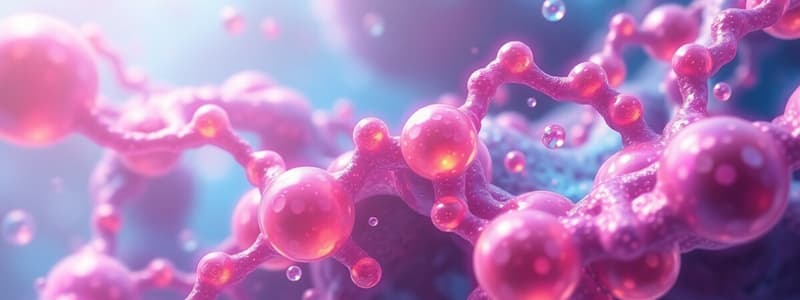Podcast
Questions and Answers
What is a key characteristic of lipids?
What is a key characteristic of lipids?
- They are polar and hydrophilic.
- They contain only carbon and oxygen.
- They are made exclusively of proteins.
- They are nonpolar and hydrophobic. (correct)
Which part of a phospholipid is hydrophilic?
Which part of a phospholipid is hydrophilic?
- The glycerol backbone.
- The carbon chains.
- The phosphate head. (correct)
- The fatty acid tails.
How are saturated and unsaturated fats structurally different?
How are saturated and unsaturated fats structurally different?
- Saturated fats have double bonds between carbon atoms.
- Unsaturated fats have multiple hydroxyl groups.
- Unsaturated fats are linear with only single bonds.
- Saturated fats are solid at room temperature, while unsaturated fats are liquids. (correct)
What process joins subunits to form lipids?
What process joins subunits to form lipids?
What is the primary component of cell membranes?
What is the primary component of cell membranes?
Which statement about fatty acids is true?
Which statement about fatty acids is true?
What effect does the structure of saturated fats have on their physical state at room temperature?
What effect does the structure of saturated fats have on their physical state at room temperature?
Which property is common to all lipids?
Which property is common to all lipids?
What is a consequence of unsaturated fats having double bonds?
What is a consequence of unsaturated fats having double bonds?
What happens to the hydrophilic phosphate heads of phospholipids in an aqueous environment?
What happens to the hydrophilic phosphate heads of phospholipids in an aqueous environment?
Flashcards
Lipids
Lipids
Organic molecules that are nonpolar and hydrophobic. They include fats, waxes, oils, and steroids.
Saturated Fatty Acid
Saturated Fatty Acid
A type of lipid with a long hydrocarbon chain. They contain carbon and hydrogen atoms connected by single bonds.
Unsaturated Fatty Acid
Unsaturated Fatty Acid
A type of lipid with a hydrocarbon chain that contains one or more double bonds between carbon atoms.
Saturated Fat
Saturated Fat
Signup and view all the flashcards
Unsaturated Fat
Unsaturated Fat
Signup and view all the flashcards
Dehydration Synthesis
Dehydration Synthesis
Signup and view all the flashcards
Phospholipid
Phospholipid
Signup and view all the flashcards
Phospholipid Bilayer
Phospholipid Bilayer
Signup and view all the flashcards
Hydrophilic
Hydrophilic
Signup and view all the flashcards
Hydrophobic
Hydrophobic
Signup and view all the flashcards
Study Notes
Lipids: Structure and Function
-
Lipids are nonpolar, hydrophobic organic molecules. Examples include fats, waxes, oils, and steroids like cholesterol, estrogen, and testosterone.
-
Key functions include energy storage, insulation, protection, cell communication, and building cell membranes.
Lipid Subunits and Synthesis
-
Complex lipids are made from smaller subunits (glycerol and fatty acids).
-
These subunits contain carbon, hydrogen, and oxygen atoms.
-
Dehydration synthesis joins the subunits, forming covalent bonds and releasing water.
Fatty Acid Structure and Saturation
-
Fatty acids have long hydrocarbon chains (carbon backbone with hydrogen atoms).
-
Each carbon forms four bonds.
-
Saturated fats: All carbons have single bonds, maximizing hydrogen atoms. This allows for tight packing, resulting in solid structure at room temperature. They are often considered less healthy.
-
Unsaturated fats: Some carbons have double bonds, causing bends and kinks in the hydrocarbon chain. This hinders close packing, resulting in liquid structure at room temperature.
Phospholipids
-
Phospholipids have two distinct regions: a hydrophilic phosphate head and two hydrophobic fatty acid tails.
-
The phosphate head has negative charges and polar bonds, making it hydrophilic (water-loving), allowing it to interact with water.
-
The fatty acid tails are nonpolar and hydrophobic (water-fearing), repelling water.
Cell Membranes
-
Cell membranes are made of a phospholipid bilayer, two layers of phospholipids.
-
The phospholipid bilayer forms a barrier between the internal and external cell environments. It controls what enters and leaves the cell.
-
The hydrophilic heads face the watery environments inside and outside the cell.
-
The hydrophobic tails face each other in the membrane's interior.
Lipid Summary
-
Lipids, containing carbon, hydrogen, and oxygen, are hydrophobic.
-
Complex lipids are assembled from smaller subunits (glycerol and fatty acids).
-
Saturated fats have straight chains, while unsaturated fats have kinks, affecting physical properties (solid vs. liquid).
-
Phospholipids are key to cell membrane structure, balancing hydrophilic heads with hydrophobic tails.
Studying That Suits You
Use AI to generate personalized quizzes and flashcards to suit your learning preferences.




